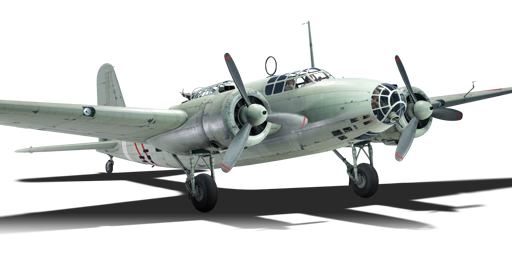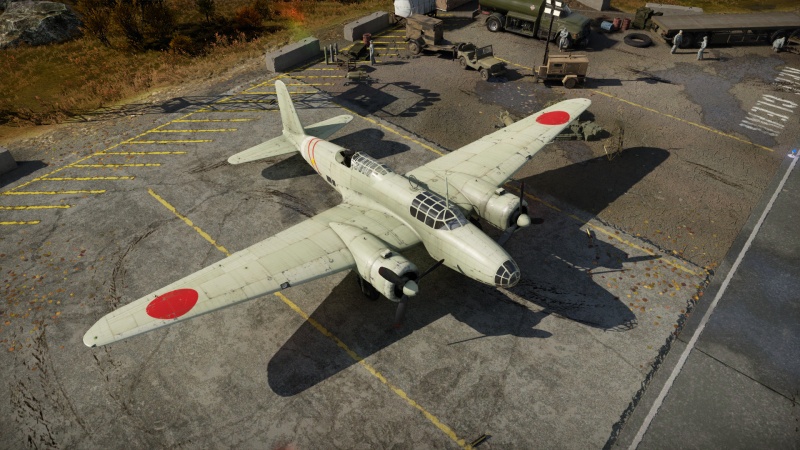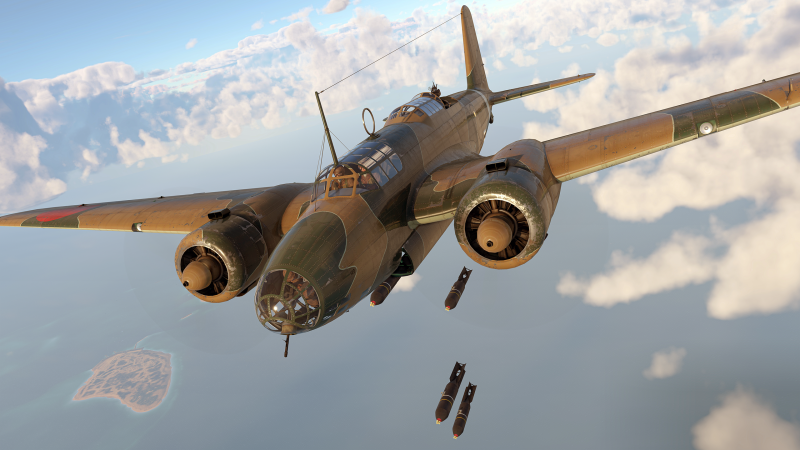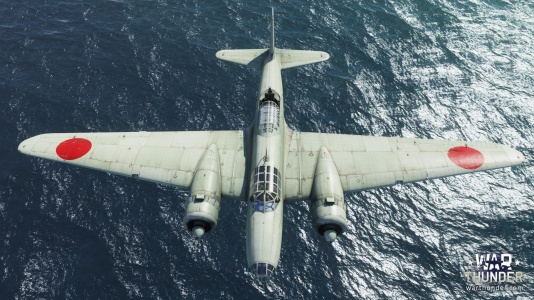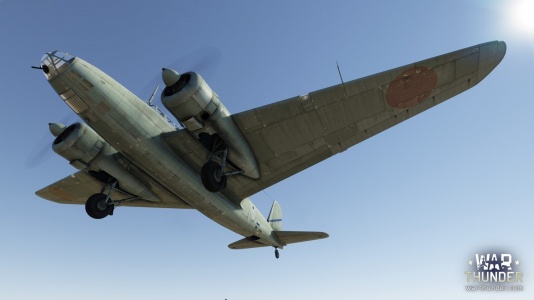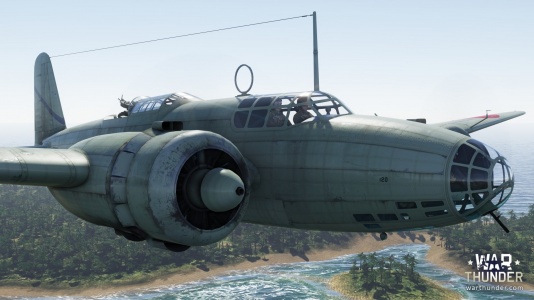Difference between revisions of "Ki-21-Ia"
Colok76286 (talk | contribs) (Edits) |
m |
||
| (8 intermediate revisions by 4 users not shown) | |||
| Line 11: | Line 11: | ||
== Description == | == Description == | ||
<!-- ''In the description, the first part should be about the history of and the creation and combat usage of the aircraft, as well as its key features. In the second part, tell the reader about the aircraft in the game. Insert a screenshot of the vehicle, so that if the novice player does not remember the vehicle by name, he will immediately understand what kind of vehicle the article is talking about.'' --> | <!-- ''In the description, the first part should be about the history of and the creation and combat usage of the aircraft, as well as its key features. In the second part, tell the reader about the aircraft in the game. Insert a screenshot of the vehicle, so that if the novice player does not remember the vehicle by name, he will immediately understand what kind of vehicle the article is talking about.'' --> | ||
| − | The '''{{ | + | The '''Ki-21''', designated as the '''Type 97 Heavy Bomber ({{Annotation|九七式重爆撃機|Kyū Nana-Shiki Jū-Bakugekiki}})''', represented a significant advancement in the Japanese Army's aerial capabilities, introducing a new strategic doctrine. Preceding licensed and modified bomber models, such as the Ki-1, Ki-2, Ki-20, and [[B.R.20 (Family)|B.R.20]], suffered sluggish speed and inadequate armament, rendering them vulnerable to interception. In contrast, the Ki-21 was conceived as a high-speed, long-range twin-engine bomber, prioritizing speed and range over armour and payload. The aim was to strike enemy airfields preemptively, before they could deploy their fighter aircraft, and to evade interception by outpacing enemy fighters. Additionally, the Ki-21 boasted self-defence armament to fend off attacks from various angles with its array of machine guns. The '''Ki-21-Ia''' emerged as the first production variant of the Ki-21 series. While initially proving more effective than its predecessors, its effectiveness waned as aerial warfare evolved throughout the war. |
| − | + | Introduced in [[Update 1.49 "Weapons of Victory"]], the '''Ki-21-I ko''' is a versatile low-altitude medium bomber renowned for its impressive manoeuvrability for a bomber, although hindered by a low total bomb capacity, it excels in targeting ground targets such as pillboxes and tanks, with preferred naval targets being destroyers and cargo ships, while its light turret armament suggests optimal performance at higher altitudes, its different bomb layouts offer versatility, with 20 x 50 kg bombs effective against multiple ground targets and 2 x 500 kg bombs recommended for bases, making it a competent early-rank bomber despite its low total bomb tonnage. | |
| − | + | ;Nicknames | |
| + | |||
| + | * IJA Pilot abbreviation: | ||
| + | ** ''Kyu-Nana Shiki Jū Baku (九七式重爆, Type 97 Heavy Bomb)'' | ||
| + | ** ''Kyu-Nana Jū Baku (九七重爆, 97 Heavy Bomb)'' | ||
| + | ** ''Kyu-Nana Jū (九七重, 97 Heavy)'' | ||
| + | * Allied reporting name: | ||
| + | ** ''Jane'' <small>- Objected by Gen. Douglas MacArthur (same name as his wife)</small> | ||
| + | ** '''Sally''' | ||
| + | ** ''Gwen'' <small>- Ki-21-IIb misreported as separate model</small> | ||
== General info == | == General info == | ||
| Line 131: | Line 140: | ||
If attacked by fighters, it is important to remember and recognize the Ki-21's turning capabilities. It is actually possible to win lateral turn fights against fighters with this aircraft as she is one of the most manoeuvrable bombers if not the most manoeuvrable bomber in game. While the Ki-21's defensive firepower isn't going to deter enemies from attacking, they still can damage enemy planes. | If attacked by fighters, it is important to remember and recognize the Ki-21's turning capabilities. It is actually possible to win lateral turn fights against fighters with this aircraft as she is one of the most manoeuvrable bombers if not the most manoeuvrable bomber in game. While the Ki-21's defensive firepower isn't going to deter enemies from attacking, they still can damage enemy planes. | ||
| − | This aircraft has the ability to hold up to | + | This aircraft has the ability to hold up to 1,000 kg of bombs in several different variations: 20 x 50 kg, 10 x 100 kg, 4 x 250 kg, and 2 x 500 kg. Use the 20 x 50 kg or 10 x 100 kg bombs to attack light tanks and light pillboxes. They are not viable against bigger targets, since direct hits are needed to destroy. This loadout is particularly useful on maps that have an abundance of non-moving targets (light pillboxes) or lightly armoured targets (armoured cars or AA trucks for example). Use either of the 4 x 250 kg or 2 x 500 kg payload to destroy heavier targets such as medium tanks, pillboxes, destroyers, and cargo ships. |
Although unconventional, this aircraft is a fantastic weapon if you want to bait the enemy. Ideally, you would want to attract a higher flying enemy down to you and to get into a turn fight. This way, depending on the enemy aircraft you can out manoeuvre and distract him while teammates fly down to finish him off. | Although unconventional, this aircraft is a fantastic weapon if you want to bait the enemy. Ideally, you would want to attract a higher flying enemy down to you and to get into a turn fight. This way, depending on the enemy aircraft you can out manoeuvre and distract him while teammates fly down to finish him off. | ||
| Line 181: | Line 190: | ||
Mitsubishi produced two prototypes of the Ki-21 to meet these standards. This new design proved superior to the design submitted by Kawasaki but was nearly on-par with Nakajima's submission. In early tests, Nakajima's prototype, the Ki-19 had more reliable engines and a better bombing platform, while the Ki-21 had better overall performance. In later rounds of testing, after the Army Air Service ordered modifications to be made to both prototypes, the Ki-21 came out on top and won the Army's contract for a heavy bomber. | Mitsubishi produced two prototypes of the Ki-21 to meet these standards. This new design proved superior to the design submitted by Kawasaki but was nearly on-par with Nakajima's submission. In early tests, Nakajima's prototype, the Ki-19 had more reliable engines and a better bombing platform, while the Ki-21 had better overall performance. In later rounds of testing, after the Army Air Service ordered modifications to be made to both prototypes, the Ki-21 came out on top and won the Army's contract for a heavy bomber. | ||
| − | Production began in November 1937 and the bomber began to see action in August 1938. The specific variant seen in game, the Ki-21-Ia, was used on the Chinese front during the Second Sino-Japanese War and against the Soviet Union during the Nomohan Incident. The Ki-21 would start off successfully during early World War 2, but by the end of World War 2 it was relegated to second line duties or kamikaze attacks. Overall 2,064 Mitsubishi Ki-21s of all variants were produced for the Japanese Army Air | + | Production began in November 1937 and the bomber began to see action in August 1938. The specific variant seen in game, the Ki-21-Ia, was used on the Chinese front during the Second Sino-Japanese War and against the Soviet Union during the Nomohan Incident. The Ki-21 would start off successfully during early World War 2, but by the end of World War 2 it was relegated to second line duties or kamikaze attacks. Overall 2,064 Mitsubishi Ki-21s of all variants were produced for the Japanese Army Air Service. |
== Media == | == Media == | ||
Latest revision as of 07:29, 28 August 2024
| This page is about the Japanese bomber Ki-21-Ia. For the gift version, see Ki-21-I hei. |
Contents
Description
The Ki-21, designated as the Type 97 Heavy Bomber (九七式重爆撃機), represented a significant advancement in the Japanese Army's aerial capabilities, introducing a new strategic doctrine. Preceding licensed and modified bomber models, such as the Ki-1, Ki-2, Ki-20, and B.R.20, suffered sluggish speed and inadequate armament, rendering them vulnerable to interception. In contrast, the Ki-21 was conceived as a high-speed, long-range twin-engine bomber, prioritizing speed and range over armour and payload. The aim was to strike enemy airfields preemptively, before they could deploy their fighter aircraft, and to evade interception by outpacing enemy fighters. Additionally, the Ki-21 boasted self-defence armament to fend off attacks from various angles with its array of machine guns. The Ki-21-Ia emerged as the first production variant of the Ki-21 series. While initially proving more effective than its predecessors, its effectiveness waned as aerial warfare evolved throughout the war.
Introduced in Update 1.49 "Weapons of Victory", the Ki-21-I ko is a versatile low-altitude medium bomber renowned for its impressive manoeuvrability for a bomber, although hindered by a low total bomb capacity, it excels in targeting ground targets such as pillboxes and tanks, with preferred naval targets being destroyers and cargo ships, while its light turret armament suggests optimal performance at higher altitudes, its different bomb layouts offer versatility, with 20 x 50 kg bombs effective against multiple ground targets and 2 x 500 kg bombs recommended for bases, making it a competent early-rank bomber despite its low total bomb tonnage.
- Nicknames
- IJA Pilot abbreviation:
- Kyu-Nana Shiki Jū Baku (九七式重爆, Type 97 Heavy Bomb)
- Kyu-Nana Jū Baku (九七重爆, 97 Heavy Bomb)
- Kyu-Nana Jū (九七重, 97 Heavy)
- Allied reporting name:
- Jane - Objected by Gen. Douglas MacArthur (same name as his wife)
- Sally
- Gwen - Ki-21-IIb misreported as separate model
General info
Flight performance
| Characteristics | Max Speed (km/h at 400 m) |
Max altitude (metres) |
Turn time (seconds) |
Rate of climb (metres/second) |
Take-off run (metres) | |||
|---|---|---|---|---|---|---|---|---|
| AB | RB | AB | RB | AB | RB | |||
| Stock | 412 | 399 | 8600 | 14.7 | 15.3 | 3.1 | 3.1 | 600 |
| Upgraded | 453 | 432 | 13.6 | 14.0 | 9.8 | 5.9 | ||
Details
| Features | ||||
|---|---|---|---|---|
| Combat flaps | Take-off flaps | Landing flaps | Air brakes | Arrestor gear |
| ✓ | ✓ | ✓ | X | X |
| Limits | ||||||
|---|---|---|---|---|---|---|
| Wings (km/h) | Gear (km/h) | Flaps (km/h) | Max Static G | |||
| Combat | Take-off | Landing | + | - | ||
| 540 | 380 | 428 | 399 | 250 | ~7 | ~2 |
| Optimal velocities (km/h) | |||
|---|---|---|---|
| Ailerons | Rudder | Elevators | Radiator |
| < 260 | < 260 | < 260 | > 320 |
| Compressor (RB/SB) | ||
|---|---|---|
| Setting 1 | ||
| Optimal altitude | 100% Engine power | WEP Engine power |
| 3,700 m | 890 hp | 1,080 hp |
Survivability and armour
- No armour
- Self-sealing fuel tanks (2 in each wing, 2 in the mid-fuselage)
Modifications and economy
Being a bomber, speed is not necessarily an important attribute, however payload and defensive armament is. Upgrading the bombs allows for more target flexibility and damage potential while turret upgrades will help survivability. the turret belts and the "new turrets" upgrades are useful. The "new turrets" upgrade will allow you to fire the turrets for longer periods of time and having access to multiple ammunition belts is also helpful. The engine upgrades are also useful in that they will help you reach your target faster and will control engine temperature. Having all of the weapons upgrades will help drastically in unlocking the other modules on this aircraft. Getting the airframe module does help in survivability as it helps your plane's durability.
Armaments
Suspended armament
The Ki-21-Ia can be outfitted with the following ordnance:
- 20 x 50 kg Army Type 94 GPHE bombs (1,000 kg total)
- 10 x 100 kg Army Type 94 GPHE bombs (1,000 kg total)
- 4 x 250 kg Army Type 92 GPHE bombs (1,000 kg total)
- 2 x 500 kg Army Type 92 GPHE bombs (1,000 kg total)
Defensive armament
The Ki-21-Ia is defended by:
- 2 x 7.7 mm Type 89 'special' machine guns, dorsal turret (450 rpg = 900 total)
- 1 x 7.7 mm Te-1 machine gun, nose turret (483 rpg)
- 1 x 7.7 mm Te-1 machine gun, ventral turret (483 rpg)
Usage in battles
If attacked by fighters, it is important to remember and recognize the Ki-21's turning capabilities. It is actually possible to win lateral turn fights against fighters with this aircraft as she is one of the most manoeuvrable bombers if not the most manoeuvrable bomber in game. While the Ki-21's defensive firepower isn't going to deter enemies from attacking, they still can damage enemy planes.
This aircraft has the ability to hold up to 1,000 kg of bombs in several different variations: 20 x 50 kg, 10 x 100 kg, 4 x 250 kg, and 2 x 500 kg. Use the 20 x 50 kg or 10 x 100 kg bombs to attack light tanks and light pillboxes. They are not viable against bigger targets, since direct hits are needed to destroy. This loadout is particularly useful on maps that have an abundance of non-moving targets (light pillboxes) or lightly armoured targets (armoured cars or AA trucks for example). Use either of the 4 x 250 kg or 2 x 500 kg payload to destroy heavier targets such as medium tanks, pillboxes, destroyers, and cargo ships.
Although unconventional, this aircraft is a fantastic weapon if you want to bait the enemy. Ideally, you would want to attract a higher flying enemy down to you and to get into a turn fight. This way, depending on the enemy aircraft you can out manoeuvre and distract him while teammates fly down to finish him off.
You should avoid any plane with cannons as this plane, while it is reasonably durable, does not like to take hits from cannon rounds. The plane that should be feared the most is the LaGG-3-34 which has the 37 mm cannon with the Air targets belts, as a single round from the 37 mm cannon will either cripple the Ki-21 or destroy it immediately.
Manual Engine Control
| MEC elements | ||||||
|---|---|---|---|---|---|---|
| Mixer | Pitch | Radiator | Supercharger | Turbocharger | ||
| Oil | Water | Type | ||||
| Not controllable | Controllable Not auto controlled |
Controllable Auto control available |
Controllable Auto control available |
Separate | Not controllable 1 gear |
Not controllable |
Pros and cons
Pros:
- Very manoeuvrable
- Extensive bombload for a rank I Japanese bomber
- Decent cruising speed
- Durable, can take some hits
- Above average defensive armament for its BR
- Internal payload
Cons:
- Loses effectiveness with altitude
- No armour
- Defensive armament is still outclassed by many
- Falls quickly when attacked by multiple foes
- Head on attacks are usually fatal because of lack of protection for the pilots
- Gunners can be knocked out easily
History
In 1936, the Imperial Japanese Army Air Service issued a requirement for a new heavy bomber to replace two previous models. This new heavy bomber had to have a crew of four to six men, a top speed of 400 km/h (250 mph), had to be able to carry a bomb load greater than 750 kg (1,650 lb), had to be able to climb to altitude in less than 8 minutes, and had to take off in less than 300 m (980 ft). The new bomber also had to utilize Nakajima Ha-5 or Mitsubishi Ha-6 engines and had to contain specific models of radios, among many other specifications. These requirements were quite extensive and there weren't many heavy bombers in existence at the time that could perform at these standards.
Mitsubishi produced two prototypes of the Ki-21 to meet these standards. This new design proved superior to the design submitted by Kawasaki but was nearly on-par with Nakajima's submission. In early tests, Nakajima's prototype, the Ki-19 had more reliable engines and a better bombing platform, while the Ki-21 had better overall performance. In later rounds of testing, after the Army Air Service ordered modifications to be made to both prototypes, the Ki-21 came out on top and won the Army's contract for a heavy bomber.
Production began in November 1937 and the bomber began to see action in August 1938. The specific variant seen in game, the Ki-21-Ia, was used on the Chinese front during the Second Sino-Japanese War and against the Soviet Union during the Nomohan Incident. The Ki-21 would start off successfully during early World War 2, but by the end of World War 2 it was relegated to second line duties or kamikaze attacks. Overall 2,064 Mitsubishi Ki-21s of all variants were produced for the Japanese Army Air Service.
Media
- Skins
- Videos
See also
Links to the articles on the War Thunder Wiki that you think will be useful for the reader, for example:
- reference to the series of the aircraft;
- links to approximate analogues of other nations and research trees.
External links
| Mitsubishi Company (三菱商会) | |
|---|---|
| Fighters | A5M4 · Hagiri's A5M4 |
| A6M2 mod. 11 · A6M2 · A6M3 · A6M3 mod. 22 · A6M3 mod. 22Ko · A6M5 · A6M5 Ko · A6M5 otsu · A6M5 Hei · A6M6c | |
| A7M1 (NK9H) · A7M2 | |
| J2M2 · J2M3 · J2M4 Kai · J2M5 · J2M5 (30 mm) | |
| Hydroplanes | F1M2 |
| Interceptors | Ki-83 · Ki-109 |
| Bombers | G4M1 |
| Ki-21-Ia · Ki-21-I hei · Ki-67-I Ko · Ki-67-I otsu | |
| Jet Fighters | Ki-200 |
| Captured | ▃A6M2 · ␗A6M2 |
| See also | Mitsubishi Heavy Industries, Ltd. (Post-War) |
| Japan bombers | |
|---|---|
| Navy | |
| Carrier-based attack bomber | |
| B5N | B5N2 |
| B6N | B6N1 · B6N2 · B6N2a |
| B7A | B7A2 · B7A2 (Homare 23) |
| Carrier-based dive bomber | |
| D3A | D3A1 |
| D4Y | D4Y1 · D4Y2 · D4Y3 Ko |
| Shipboard Observation seaplane | |
| F1M | F1M2 |
| Land-based Attack bomber | |
| G4M | G4M1 |
| G5N | G5N1 |
| G8N | G8N1 |
| Flying boat | |
| H6K | H6K4 |
| H8K | H8K2 · H8K3 |
| Land-based Bomber | |
| P1Y | P1Y1 |
| Army | |
| Light | Ki-32 |
| Ki-48-II otsu | |
| Heavy | Ki-21-Ia · Ki-21-I hei |
| Ki-49-I · Ki-49-IIa · Ki-49-IIb · Ki-49-IIb/L | |
| Ki-67-I Ko · Ki-67-I otsu | |
| Other countries | ▅B-17E |


